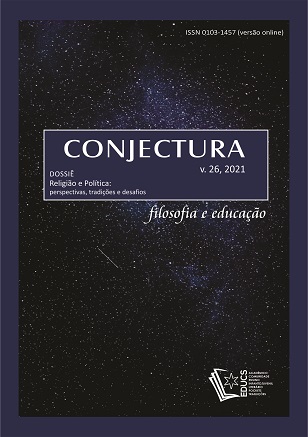Religion and education: elements for self-transformation of the human being
DOI:
https://doi.org/10.18226/21784612.v26.e021042Abstract
This illustration aims to present the contributions of religion, as an alert, to the distancing from different types of criminality. It identifies which benefits the religious experience, more specifically, the feelings of faith and religiosity. It brings to the person who is in a situation of delinquency and the margin of society, due to his acts committed against the norms established for the harmonious coexistence of society. In addition, it seeks to present social factors intertwined with the criminality situation, that is, elements that can contribute to the individual’s inclination towards disgrace. Therefore, in the execution of the present study, bibliographic research was used, based on books and scientific articles. In addition, theses and similar monographs were also consulted, whose main bases are the illustrations of the Frenchman, René Girard (1990), who presents his theories of mimetic desire and scapegoat. There is also support from other authors, among them, Friedrich Nietzsche (2014), Karl Marx (1983) and Jessé Souza (2018). Consequently, it presents several contributions that religion can promote to people who are in a situation of criminality, as well as sought to identify the role of religion within a society. Thus, the text aims to expose some of the contributions of religion that were found in the bibliographic research carried out, in order to understand how the feeling of faith and religiosity can benefit people in general, but also those who today, for certain reasons, are in an unfavorable situation, that is, in a situation of delinquency and also those who may be inclined to acts considered anti-social.
Keywords: Religion. Crime. Faith. Religiosity. Social factors.
References
AGÊNCIA IBGE NOTÍCIA. Censo 2010: número de católicos cai e aumenta o de evangéli-cos, espíritas e sem religião. Disponível em: < https://cutt.ly/vhjdZBQ> Acesso em: 15 de out. 2020.
BOFF, Leonardo. Ethos mundial: um consenso mínimo entre os humanos. Brasília: Letraviva, 2000.
BRASIL, BRASÍLIA. Lei nº 7.210 de 11 de julho de 1984. Lei de execuções penais. Disponí-vel em: < https://www.planalto.gov.br/ccivil_03/Leis/L7210.htm>. Acesso em: 15 de set. 2020.
CIPRIANI, R. Manual da sociologia. São Paulo: Paulus, 2007.
CONSELHO NACIONAL DE JUSTIÇA. Departamento de monitoramento e fiscalização. Relatório do Mutirão Carcerário Realizado no Estado do Pará. Belém, 2010. Disponível em: < https://www.cnj.jus.br/> Acesso em: 30 de ago. 2020.
DIAS, Maria da Luz Vale. Religiosidade e comportamento desviante na adolescência: dados de um estudo empírico. Revista Portuguesa de Pedagogia. Coimbra, p. 5-23, 1 jul. 2011.
GREGÓRIO, Sérgio Biagi. Religião. Disponível em < https://sites.google.com/view/sbgdicionariodefilosofia/religi%C3%A3o>. Acesso em 27 de out. 2020.
DUARTE, Lucas Henrique Pereira. A sacralidade da violência do estado: o cárcere à luz do bode expiatório de René Girard. 2017. 62 f. TCC (Graduação) - Curso de Licenciatura Plena em Filosofia, Faculdade de São Bento, São Paulo, 2017.
GALÚCIO, Iarani Augusta Soares. Os impactos da assistência religiosa no processo de resso-cialização de presos. Anais do Congresso Internacional da Faculdades, São Leopoldo, v. 1, p. 1219-1238, 2012.
GARRIDO, Adriana Cristina Oliver. Fatores sociais de criminalidade. Disponível em: < http://www.atenas.edu.br/uniatenas/assets/files/magazines/FATORES_SOCIAIS_DE_CRIMINALIDADE_.pdf>. Acesso em 13 ago. 2020.
GIRARD, Rene. A violência e o sagrado. São Paulo: Paz e Terra, 1990. 392 p.
IBGE. Amostra-Religião. Disponível em <https://cidades.ibge.gov.br/brasil/pesquisa/23/22107> Acesso em: 12 de out. 2020.
JENSEN, Gary F; ROJEK, Dean G. Delinquency and youth crime. 4. ed. Linois: Waveland Press, 1998. 478 p.
LONGHI, Miguel. O ethos no currículo de ensino religioso. 2004. 61 f. Dissertação (Mestra-do) - Curso de Mestre em Educação, Pontifícia Universidade Católica do Paraná, Curitiba, 2004.
MARX, Karl. O capital. São Paulo: Abril Cultural, 1983. 1493 p.
MELO, Daniela Canazaro de et al. Influência da religiosidade e sintomas de desesperança em mulheres prisioneiras. Psicologia para América Latina. Porto Alegre, v. 24, p. 97-108, 2013.
NIETZSCHE, Friedrich. Crepúsculo dos ídolos. Petrópolis: Vozes, 2014. 208 p.
NOVAES, R. Juventude e participação social: apontamentos sobre a reinvenção da política. In: ABRAMO, Helena, Wendel, Freitas, Maria Virgínia de SPOSITO, Marília Pontes (org.,). Ju-ventude em debate. São Paulo: Cortez, p. 46-55, 2000.
RADCLIFFE-BROWN, A. R. The andaman islanders. Cambridge: Cambridge University Press, 1952
SHIKIDA, Claudio Djissey; ARAÚJO JUNIOR, Ari Francisco de; MURTA, Susane Rodri-gues. Religião e criminalidade no Brasil: primeiras evidências sob enfoque econômico. Revista Textos de Economia (TEC), Florianópolis, v. 11, n. 2, p. 91-107, 2008.
SOUZA, Jessé. Ralé brasileira: quem é e como vive. 3ª Edição. Belo Horizonte: Editora UFMG, 2018. 528 p.
SOUZA, Robson Sávio Reis. Religião e criminalidade: da cultura da morte à cultura da paz e do perdão. Horizonte, Belo Horizonte, v. 3, n. 6, p. 97-120, 2005.
Downloads
Published
How to Cite
Issue
Section
License
1. The publication of the originals will imply the assignment of copyright to Conjectura Journal.
2. Texts cannot be reproduced without authorization from the Journal after acceptance.









